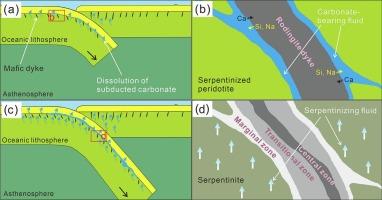IF 3.6
2区 地球科学
Q1 GEOCHEMISTRY & GEOPHYSICS
引用次数: 0
摘要
罗丁岩是一种富含钙但缺乏钠和硅的岩石,通过流体-岩石反应形成,对于理解海洋物质循环至关重要。然而,钙在岩石中的来源仍有争议。岩脉从岩心到边缘呈递进交代作用,划分为中心带、过渡带和边缘带。岩脉δ44/40Ca值变化范围为0.28‰~ 1.63‰,Sr同位素变化有限(87Sr/86Sr(i) = 0.70308 ~ 0.70438)。中度交代的中央岩的δ44/40Ca值较MORB低(0.53‰~ 0.68‰),中度交代的过渡岩的δ44/40Ca值较MORB低(0.28‰~ 0.61‰)。深交代边缘岩δ44/40Ca值最高(0.64‰~ 1.63‰)。岩石岩脉上δ44/40Ca值的横向剖面显示出明显的振荡分带,表明岩石岩化过程中存在多种流体来源。在早期,基性岩脉被低δ44/40Ca的含碳酸盐流体交代,该流体来源于俯冲过程中与沙漠化有关的流体与海相碳酸盐的混合作用。随后,高δ44/40Ca的蛇纹岩化流体对岩脉进行了更强烈的交代作用,导致Ca输入增加,δ44/40Ca值升高。87Sr/86Sr(i)比值由中心区向边缘区逐渐增大,表明原生流体来源于海水引发的蛇纹岩作用。研究认为,在俯冲初期,蛇纹岩脱水释放的流体溶解了俯冲洋板上的沉积碳酸盐。随着俯冲的进行,周围蛇纹岩的广泛脱水产生了高δ44/40Ca的蛇纹岩化流体,进一步提高了岩脉的δ44/40Ca和87Sr/86Sr(i)值。不同构造背景下岩屑岩的δ44/40Ca值变化很大,支持岩屑化过程中具有不同钙同位素组成的多种流体贡献模式。本文章由计算机程序翻译,如有差异,请以英文原文为准。

Origin of rodingites in the Xigaze ophiolite, SW Tibet: Constraints from Ca and Sr isotopes
Rodingites, extremely calcium-rich but sodium- and silicon-poor rocks forming through fluid-rock reactions, are crucial for understanding the oceanic cycling of materials. However, the source of calcium in rodingites remains debated. Here, we investigate whole rock Ca and Sr isotopic compositions of samples collected across a continuous section of a rodingite dyke from the Xigaze ophiolite, SW Tibet. The rodingite dyke exhibits progressive metasomatism from core to margin, defining central, transitional, and marginal zones. The dyke displays a wide range of δ44/40Ca values from 0.28 ‰ to 1.63 ‰ but limited variation in Sr isotope (87Sr/86Sr(i) = 0.70308–0.70438). The slightly metasomatized central rodingites exhibit lower δ44/40Ca values (0.53 ‰ to 0.68 ‰) than MORB, whereas the moderately metasomatized transitional rodingites display significantly lighter Ca isotope compositions (δ44/40Ca = 0.28 ‰ to 0.61 ‰). The intensively metasomatized marginal rodingites show the highest δ44/40Ca values (0.64 ‰ to 1.63 ‰). The transverse profile of δ44/40Ca values across the rodingite dyke reveals clear oscillatory zoning, suggesting multiple fluid sources for Ca during rodingitization. In the early-stage, the mafic dyke was metasomatized by a carbonate-bearing fluid characterized by low δ44/40Ca values, which originated from the mixing of deserpentinization-related fluids with marine carbonates during subduction. Subsequently, the dyke experienced more intense metasomatism by a high-δ44/40Ca serpentinizing fluid, leading to additional Ca input and an elevation of δ44/40Ca values. The gradual increase in 87Sr/86Sr(i) ratios from the central zone to the marginal zone indicates that the primary fluids were derived from seawater-triggered serpentinization. This study proposes that during the initial stages of subduction fluids released by serpentinite dehydration dissolved sedimentary carbonates on the subducted oceanic slab. As subduction progressed, extensive dehydration of the surrounding serpentinites produced high-δ44/40Ca serpentinizing fluids, which further elevated both δ44/40Ca and 87Sr/86Sr(i) values of the dyke. The highly variable δ44/40Ca values of rodingites from diverse tectonic settings support the model involving multiple fluid contributions with distinct Ca isotopic compositions during rodingitization.
求助全文
通过发布文献求助,成功后即可免费获取论文全文。
去求助
来源期刊

Chemical Geology
地学-地球化学与地球物理
CiteScore
7.20
自引率
10.30%
发文量
374
审稿时长
3.6 months
期刊介绍:
Chemical Geology is an international journal that publishes original research papers on isotopic and elemental geochemistry, geochronology and cosmochemistry.
The Journal focuses on chemical processes in igneous, metamorphic, and sedimentary petrology, low- and high-temperature aqueous solutions, biogeochemistry, the environment and cosmochemistry.
Papers that are field, experimentally, or computationally based are appropriate if they are of broad international interest. The Journal generally does not publish papers that are primarily of regional or local interest, or which are primarily focused on remediation and applied geochemistry.
The Journal also welcomes innovative papers dealing with significant analytical advances that are of wide interest in the community and extend significantly beyond the scope of what would be included in the methods section of a standard research paper.
 求助内容:
求助内容: 应助结果提醒方式:
应助结果提醒方式:


